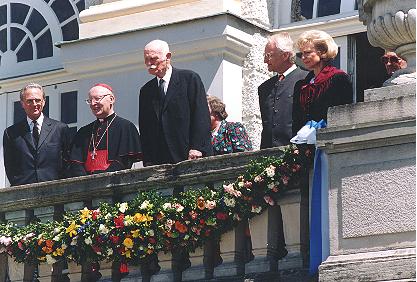 |
 |
 |
 |
 |
 |
 |
 |
 |
Albert I
At the death of his grandmother Mary Theresa, February 3, 1919, Albert's father Rupert succeeded to all of his mother's British rights. Albert was henceforward recognised by the Jacobites as "Duke of Cornwall and Rothesay, Earl of Carrick, Baron of Renfrew, Lord of the Isles, and Prince and Great Steward of Scotland". At the death of his grandfather King Ludwig III of Bavaria, October 18, 1921, Albert became heir to the Bavarian throne after his father; henceforward he used the title "Hereditary Prince of Bavaria". He lived in the Rehbach-Stöckerl of Schloss Berchtesgarden, and then studied forestry at the University of Munich. On September 3, 1930, in the Stiftskirche at Berchtesgarden, Albert married Countess Marita Draskovich von Trakostjan, daughter of Count Dionys Draskovich von Trakostjan and of his wife, Princess Julia of Montenuovo. This marriage was not in conformity with the laws of the House of Wittelsbach respecting succession to the Bavarian throne. In consequence, Marita was not properly styled "Hereditary Princess of Bavaria" until May 18, 1949, when Albert's father Rupert recognised the marriage as dynastic for Bavaria. The couple lived first at Wildbad Kreuth. They had four children:
After the war Albert established a new home at Schloss Berg on the Starnberger See. At the death of his father Rupert, August 2, 1955, Albert succeeded to all of his British rights. He was henceforward recognised by the Jacobites as "King Albert I". As Head of the House of Bavaria he now used the title "Duke of Bavaria". Albert's wife Marita died at Wildbad Kreuth, June 10, 1969. On April 21 (civil) and April 22 (religious), 1971, at Munich, Albert married Countess Marie-Jenke Keglevich von Buzin, daughter of Count Stephen Keglevich von Buzin and of his wife, Countess Clara Zichy de Zich et Vasonykeo. Marie-Jenke died at Weichselboden near Mariazell, October 5, 1983. On May 3, 1995 Albert celebrated his ninetieth birthday at Schloss Nymphenburg.
Albert greeted his subjects from the balcony of the palace. He was joined by his elder son Francis, the Cardinal Archbishop of Munich, his elder daughter the Princess of Waldburg-Zeil (partly hidden), the Prime Minister of Bavaria and his wife, and his younger son Max-Emanuel (partly hidden). Albert was a great lover of the outdoors; he particularly enjoyed hunting. The University of Munich honoured him with an honourary doctorate in veterinary medicine. He was a great promoter of Bavarian culture, especially of folk-dancing. He was Grand Master of the Order of St. George, of the Military Order of Maximilian-Joseph, and of the Order of Saint Hubertus. He was also a Bailiff Grand Cross of Honour and Devotion of the Sovereign Military Order of Malta and (from 1953) a Knight of the Order of the Golden Fleece (Austrian obedience). Albert died at Schloss Berg, July 8, 1996, when he was succeeded in all his British rights by his elder son Francis. His remains lie in the family cemetery he established at Kloster Andechs.
This page is maintained by Noel S. McFerran (noel.mcferran@rogers.com) and was last updated June 26, 2010. © Noel S. McFerran 1997-2010. |

